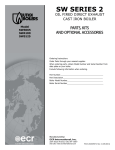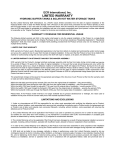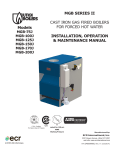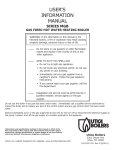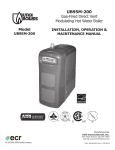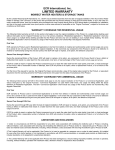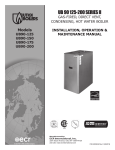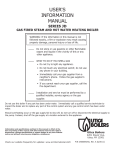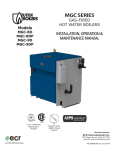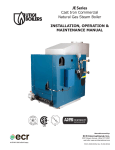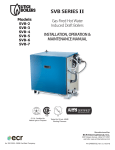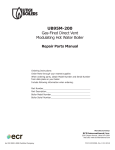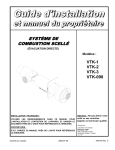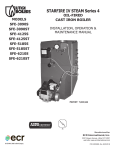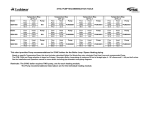Download Utica Boilers SW Series II Operation and Installation Manual
Transcript
SW SERIES 2 OIL FIRED DIRECT EXHAUST CAST IRON BOILER Model SW3065 SW4100 SW5125 INSTALLATION, OPERATION & MAINTENANCE MANUAL Tested For 75 psig ASME Working Pressure Manufactured by: ECR International, Inc. An ISO 9001-2008 Certified Company 2201 Dwyer Avenue, Utica NY 13501 web site: www.ecrinternational.com P/N# 240009678, Rev. B [02/2013] DIMENSIONS A LENGTH OF FLUSH JACKET B FRONT OF CASTING TO CENTER LINE OF FLUE OUTLET DIAMETER OF FLUE OUTLET SW3065 17 7/8" 11 1/4" 4" SW4100 21 1/2" 12 5/8" 4" SW5125 25 1/8" 14 1/4" 4" BOILER NO. 2 C TABLE OF CONTENTS Dimensions................................................................................................................................. 2 Safety Symbols .......................................................................................................................... 3 Installation ................................................................................................................................ 4 Connecting Supply And Return Piping ............................................................................................. 5 Recommended Piping For Boilers Equipped With A P3 Or T4 Tankless Heater........................................ 9 Options Utilizing 3/4" Tapping ......................................................................................................10 Oil Tank And Piping .....................................................................................................................11 Electrical Wiring .........................................................................................................................12 Sequence Of Operation................................................................................................................14 Operating Instructions.................................................................................................................15 Instructions To Obtain Proper Operation Of The Boiler-Burner Unit ....................................................16 Preventive Maintenance ...............................................................................................................17 Instructions For Opening And Closing Burner Swing Door .................................................................17 Ratings and Data ........................................................................................................................18 Service Check List ......................................................................................................................19 KEEP THIS MANUAL NEAR BOILER RETAIN FOR FUTURE REFERENCE IMPORTANT: Read the following instructions COMPLETELY before installing. Boiler installation shall be completed by qualified agency. Safety Symbols & Warnings The following defined symbols are used throughout this manual to notify the reader of potential hazards of varying risk levels. Keep boiler area clear and free from combustible materials, gasoline and other flammable vapors and liquids. DO NOT obstruct air openings to the boiler room. Modification, substitution or elimination of factory equipped, supplied or specified components may result in personal injury or loss of life. TO THE OWNER - Installation and service of this boiler must be performed by a qualified installer. TO THE INSTALLER - Leave all instructions with boiler for future reference. ! ! WARNING DANGER Indicates a hazardous situation which, if not avoided, WILL result in death or serious injury ! WARNING Indicates a hazardous situation which, if not avoided, could result in death or serious injury. ! ! WARNING CAUTION Fire, explosion, asphyxiation and electrical shock hazard. Improper installation could result in death or serious injury. Read this manual and understand all requirements before beginning installation. Indicates a hazardous situation which, if not avoided, could result in minor or moderate injury. NOTICE NOTICE Used to address practices not related to personal injury. When this product is installed in the Commonwealth of Massachusetts installation must be performed by a Licensed Plumber or Licensed Gas Fitter. 3 INSTALLATION ! WARNING ! WARNING Improper installation, adjustment, alteration, service or maintenance could result in death or serious injury. Fire hazard. Do not install boiler on combustible flooring or carpeting. Failure to follow these instructions could result in death or serious injury. Installation Installation shall conform to requirements of authority having jurisdiction or in the absence of such requirements, NFPA 31: Installation Code for Oil Burning Equipment. FOR INSTALLATION ON NON-COMBUSTIBLE FLOORS ONLY - The boiler must not be installed on carpeting or vinyl flooring. Minimum clearances to combustible construction are: Minimum clearances to combustible construction are: Where required by authority having jurisdiction, installation shall conform to standard for Controls and Safety Devices for Automatically fired boilers, ANSI/ASME CSD-1. TOP .................................................0 FRONT .... ......................................24 FLUE CONNECTOR .............................2 REAR ...............................................6 LEFT SIDE ........................................0 RIGHT SIDE ......................................0 * "FOR ALCOVE INSTALLATION" Locate boiler in front of final position before removing crate. Provide level solid base as near to vent outlet as possible and centrally located with respect to heat distribution system as practical. Allow 24 inches in front and top for servicing and cleaning, or removing tankless water heating coil. IN. IN.* IN. IN. IN. IN. Recommended clearance for service access should exceed fire protection clearance. When installed in utility room, door should be wide enough to allow largest boiler part to enter, or permit replacement of another appliance such as water heater. TOP ............................................... 24 FRONT ........................................... 24 FLUE CONNECTOR .............................9 REAR ...............................................6 LEFT SIDE ...................................... 10 RIGHT SIDE ......................................6 IN. IN. IN. IN. IN. IN. Remove crate and plastic protective wrapper and inspect for damage. Our responsibility ceases upon delivery of the crated boiler to the carrier in good condition. Any claims for damage or shortage in shipment must be filed immediately against carrier by consignee. Move boiler to permanent position by sliding or walking. 4 CONNECTING SUPPLY AND RETURN PIPING Circulators in following illustrations are mounted on system supply side, mounting on system return side is also acceptable practice. Figure 1 - Typical Installation Using Circulators Figure 2 - Typical Installation Using Zone Valves 5 CONNECTING SUPPLY AND RETURN PIPING 1. Typical installation using circulators shown in Figure • Method used to protect systems using radiant panels and material they are encased in from high temperature supply water from boiler. See Figure 3. 1. 2. Typical installation using zone valves shown in Figure 2. • Method used to protect boilers from condensate forming due to low temperature return water. Generally noticed in large converted gravity systems or other large water volume systems. See Figure 4. 3. Hot water boilers installed above radiation level must be provided with low water device either as part of boiler or at time of boiler installation. • Method used to protect boilers from condensate forming as well as protecting heating system from high water temperature. See Figure 5. 4. When boiler is connected to heating system utilizing multiple zoned circulators, each circulator must be supplied with flow control valve to prevent gravity circulation. • Reduced pressure back flow preventer must be present under provisions required by Environmental Protection Agency (EPA). 6. When using bypass piping, adjust valves A and B until desired system temperature is obtained. 7. Bypass loop piping must be same size piping for supply and return. 5. Bypass piping is an option which gives ability to adjust 8. Connect supply and return piping as suggested in supply boiler water temperature to fit system or condition of installation. This method of piping is not typically required for baseboard heating systems. Figure 6, when boiler is used in connection with refrigerated systems: Figure 3 Check local codes for maximum from floor or allowable safe point of discharge 6 CONNECTING SUPPLY AND RETURN PIPING Figure 4 Check local codes for maximum from floor or allowable safe point of discharge Figure 5 Check local codes for maximum from floor or allowable safe point of discharge 7 CONNECTING SUPPLY AND RETURN PIPING A. Chilled medium must be in parallel with the boiler. ! WARNING B. Use appropriate valves to prevent chilled medium from entering heating boiler. Burn and scald hazard. Safety relief valve could discharge steam or hot water during operation. 9. During heating cycle open valves A and B, close valves Install discharge piping from safety relief valve. C and D. • Use ¾” or larger pipe. 10. During heating cooling cycle open valves C and D, close • Use pipe suitable for temperatures of 375°F (191°C) or greater. valves A and B. A. Maintain minimum clearance of one inch to hot water pipes. • Individual boiler discharge piping shall be independent of other discharge piping. In air handling units where they may be exposed to refrigerated air circulation, boiler piping system MUST be supplied with flow control valves or other automatic means to prevent gravity circulation of boiler water during cooling cycle. • Size and arrange discharge piping to avoid reducing safety relief valve relieving capacity below minimum relief valve capacity stated on rating plate. • Run pipe as short and straight as possible to location protecting user from scalding and properly drain piping. • Install union, if used, close to safety relief valve outlet. • Install elbow(s), if used, close to safety relief valve outlet and downstream of union (if used). • Terminate pipe with plain end (not threaded). Figure 6 Check local codes for maximum from floor or allowable safe point of discharge 8 RECOMMENDED PIPING FOR BOILERS EQUIPPED WITH A P3 OR T4 TANKLESS HEATER ! DANGER Burn, scald hazard. Water temperatures exceeding 125º F will cause severe burns instantly or death by scalding. • An automatic mixing valve must be installed on the outlet of the domestic coil. Installation must comply with the valve manufacture’s recommendations, and instructions. • Do not remove the bolts or limit at the time of installation. • Pipe in accordance with the installation manual. • Due to varying water conditions, an adjustable flow restrictor must be installed in the cold water inlet of this coil. Figure 7 Recommended Piping For Boilers Equipped With A P3 Or T4 Tankless Heater 9 OPTIONS UTILIZING 3/4" TAPPING Figure 8 - Optional Location For Air Vent Figure 9 - Optional Location For Expansion Tank (Non-Diaphragm Type) 10 OIL TANK AND PIPING Install Oil tank and piping in accordance with the National Board of Fire Underwriters and in absence of such regulations in accordance with authority having jurisdiction. Oil storage tank, vent, fill pipe and caps should be in accordance with the authority having jurisdiction. A. In no case should vent pipe be smaller than 1-1/4" I.P.S. B. Fill pipe should not be less than 2" I.P.S. • Do not run overhead fuel lines from tank to oil burner. • Fuel pump connections and by-pass should be made according to instructions attached to fuel pump. If tank is more than 20' from the boiler, a two stage fuel unit should be installed in place of single stage pump supplied as standard equipment with burner. Make certain rotation and speed are same and pump is suitable for burner horsepower rating. • Oil line filter and shut-off valve should be installed in suction line. • Suction line from tank to burner should be one continuous piece of tubing to prevent air entering line. Suction line, must be 3/8" O.D. copper tubing for runs of 50 feet or less, and 1/2" O.D. for longer runs. • Shut-off valves should be installed in both suction and return lines at burner for convenience in servicing burner. • Oil return line, same size as suction line, must be used on any installation where bottom of tank is below fuel unit of burner. • Allow extra tubing at burner so burner may be removed from boiler for cleaning without disconnecting tubing. (See Figures 10 & 11). • Oil lines should be buried or otherwise protected from mechanical injury. • A UL approved flexible oil line may be used. • Flare fittings on all oil lines are recommended. • Compression fittings on suction line often allow air to be drawn into fuel pump, making it difficult to maintain oil pressure at nozzle. Figure 10 - Typical Installation Single Pipe Oil System Figure 11 - Typical Installation Two Pipe Oil System 11 ELECTRICAL WIRING Install electrical wiring in accordance with requirements of authority having jurisdiction, or in the absence of such requirements, NFPA 70: Electrical Code. • Separate electrical circuit should be run from entry box with fused disconnect switch in this circuit. • See wiring diagrams in Figures 12 & 13 for suggested circuitry and field wiring see Normal Sequence of Operation in this manual. • Wiring for zone valve installations are furnished with zone valve packages. Figure 12 - Wiring Diagram For Oil Fired Boilers Less Tankless Heater And Beckett Burner 12 ELECTRICAL WIRING Figure 13 - Wiring Diagram For Oil Fired Boilers With Tankless Heater And Beckett Burner 13 ELECTRICAL WIRING Thermostat Installation 1. Install thermostat on inside wall about four feet above floor. 2. Never install thermostat on outside wall. 3. Do not install thermostat where it will be affected by: A. B. C. D. E. F. 4. Check thermostat operation by raising and lowering thermostat as required to start and stop burner. 5. Instructions for final adjustment of thermostat are packaged with thermostat (adjusting heating anticipator, calibration, ect.). Drafts Hot or cold pipes Sun light Lighting fixtures Television sets A fireplace or chimney SEQUENCE OF OPERATION Sequence of Operation - Non-Tankless Sequence of Operation - Tankless • Thermostat calls for heat. • Thermostat will activate, completing circuit to limit control. • Circulator turns on. • Circulator motor starts and power is switched to limit. If limit circuit is closed burner motor circuit is energized. • Limit checks boiler water temperature. Burner ignition delayed until limit determines call for heat cannot be met by residual heat in boiler and heat distribution system. See limit literature for additional information. • Burner motor starts prepurge and approximately 15 seconds after solenoid valve opens and ignition system is activated, ignition will begin. • Burner and circulator operation continues until thermostat stops call for heat. • In event boiler water temperature exceeds high limit setting on boiler mounted limit control; Power will be interrupted between limit control and ignition system. Burner motor will continue to run in post purge mode for approximately 2 min. or until water temperature drops below high limit setting. Circulator will continue to operate under this condition until thermostat is satisfied. • When thermostat is satisfied power is interrupted to boiler mounted limit control and burner will run in post purge mode for 2 minutes. 14 OPERATING INSTRUCTIONS Venting system should be inspected at start of each heating season. • Check vent pipe from boiler to termination cap for signs of deterioration by rust or cracked silicone joints. Repair if necessary. • Lever of safety relief valve, shown in Figure 17, on page 18, on boiler should be operated periodically to make sure it is functioning properly. Pressure relief valve should open before water pressure exceeds 30 psi. reading on gauge. If pressure is exceeded and pressure relief valve leaks water when boiler is operating at normal pressures, immediately replace. Corrosion can build up rapidly at valve seat preventing it functioning as safety device. Start-up and adjustment of oil burner (See oil burner instructions for nozzle and electrode setting). A. Check oil burner nozzle to make certain it is tight in adapter. Burner mounting bolts should be tight. B. Check electrode setting, as they may have been jarred out of position during transportation. C. Lubricate burner motor and circulator motor if required. Some circulators are water lubricated and do not require oiling. D. Set room thermostat to call for heat. E. Open all oil line valves. F. Turn service switch on. Burner should start. G. On one pipe fuel systems only, vent pump as soon as burner starts. Allow oil to run until all traces of air in the suction line disappear. H. Turn “OFF” burner and install pressure gauge in port on pump. I. Start burner again and check oil pressure for 140 psi. Adjust if necessary. Instruments are only reliable method to determine proper air adjustments. Improperly adjusted burner causes soot and high fuel bills because of incomplete combustion of fuel oil. This in turn may require excessive boiler maintenance, service costs. Consult competent service mechanic to make proper adjustments with smoke tester, CO2 indicator and draft gauge. Bacharach or Dwyer test kits include these instruments. • 1/4" diameter slot is provided in inspection cover plate to take draft reading in combustion chamber. • 3/8" hole is provided in vent appliance adapter to take draft, CO2, smoke, and temperature readings. • Adjust air dial on oil burner to obtain trace of smoke. Measure CO2 at this point and increase air setting until CO2 = 1-1.5% lower than reading at trace point. • Check draft over fire and in vent, normal readings will be positive (+.01 Over-fire & +.02 In Vent) W.C. Table page 17 is provided as guideline for initial startup. Final adjustments MUST be made using combustion instruments as previously mentioned. 15 INSTRUCTIONS TO OBTAIN PROPER OPERATION OF THE BOILER-BURNER UNIT Check Safety Control Circuit after burner adjustments have been made for satisfactory performance. BECKETT SETTINGS Boiler No. Burner No. Air Damp Pin Pump Pressure Head Nozzle Furnished SW3065 AFII 100 3.25 3 140 PSI HLX 6 .60 45B SW4100 AFII 100 7.50 5 140 PSI HLX 6 .85 45B SW5125 AFII 150 5.00 8 140 PSI HLX 6 1.10 45B A. HIGH LIMIT CONTROL: remove cover and note temperature setting. See figure 15 on page 15. With burner operating, decrease this setting to minimum point. When boiler water temperature exceeds this set point, high limit switch will open, shutting off power to oil burner and starting post purge cycle for approximately 2 minutes. Return setting to desired high limit point. Burner should restart. B. PRIMARY CONTROL AND FLAME SENSOR: To Check: • Flame failure - simulate by shutting off oil supply with hand valve while burner is on. 15 seconds after flameout, safety switch locks out, ignition stops, motor stops and oil valve closes. To restart, open oil supply valve and reset safety switch. • Ignition failure - with burner off, unplug electrical disconnect on burner harness. Disconnect one wire from transformer and put wire nut on disconnected wires . Restore power and run through start-up procedure, safety switch should lockout as flame failure. Reconnect wires after this procedure is complete. • Power failure - Turn off main power supply switch while burner is operating. When burner stops, restore power and burner should start. If operation is not as described as above, check wiring and controls. 16 PREVENTIVE MAINTENANCE Preventive Maintenance of oil fired boiler reduces operating costs. Boiler and vent pipe should be inspected for accumulation of soot or scale deposits periodically but at least once every year before start of each heating season. When soot is present on section walls and flueways, improper combustion will result, causing additional sooting and scaling until flueways are completely closed. To remove soot and scale from flueways, remove top jacket panel, top clean-out plate, and open burner swing door. (Figure 14). Periodic Inspection and tightening of tankless heater/ cover plate bolts will reduce risk of leaks. INSTRUCTIONS FOR OPENING AND CLOSING BURNER SWING DOOR Instructions for Opening Burner Swing Door 1. Turn off power to boiler. 2. Allow boiler to cool down. 3. Disconnect power cable at factory supplied burner electrical disconnect. See Figure 15. 4. Loosen screws on sides of lower front jacket panel. See Figure 15. 5. Pull bottom part of lower front panel forward. 6. Lift lower front panel up and off boiler. See Figure 15. 7. Close oil valve. See Figures 10 and 11. 8. Disconnect oil line from burner. 3. 4. 5. 6. Replace oil line to burner. Replace inlet air pipe. Replace lower jacket panel, and tighten screws. Connect power cable at factory supplied burner electrical disconnect. 7. Turn on power to boiler. 8. Bleed oil line. Figure 14 NOTICE Do not try to swing door with oil line attached 9. Disconnect inlet air pipe from side of burner. 10. Remove nut from swing door stud on right hand side of door. 11. Swing open burner and door to left. 12. Using flue brush, brush soot and scale into combustion space where it can be removed through swing door opening. NOTICE Use caution when vacuuming in the chamber area. Damage to chamber could result. Figure 15 Recommend to replace nozzle at start of each heating season. Lubricate burner motor and circulator motor - if required - with few drops of good grade light motor oil. Do not over oil. Have competent service person service burner, check controls and check electrodes for carbon or cracks in insulators. Burners should be adjusted to produce conditions shown in Start-up and Adjustment of Oil Burner procedure. Instructions for Closing Burner Swing Door 1. Swing burner and door to right until insulation is slightly compressed and stud is exposed. 2. Attach nut to stud and tighten it until built in stop contacts mounting door. 17 RATINGS AND DATA RATINGS AND DATA BOILER MODEL NUMBER OIL BURNER INPUT(1) HEATING CAPACITY AHRI NET RATINGS (2) A.F.U.E. G.P.H. MBH MBH* WATER MBH RATING SW3065 .65 91 78 68 85.0 SW4100 1.00 140 120 104 85.0 SW5125 1.25 175 150 130 85.0 NOTES: 1. AHRI burner input is based on an oil heating value of 140,000 Btu/gal. 2. Net AHRI Water Ratings shown are based on a piping and pickup allowance of 1.15. Consult manufacturer before selecting boiler for installations having unusual piping and pickup requirements, such as intermittent system operation, extensive piping. 3. 120 Volts, 15 Amps, & 60 Hz. required to operate this boiler. STANDARD EQUIPMENT: Crated Boiler, Flush Jacket, Oil Burner, Target Wall/Liner, Circulator-1 1/4", Safety Relief Valve, Temperature Pressure Gauge, Drain Valve, Wiring Harness, Burner Electrical Disconnect, Plastic Cover, Supply Tapping 2", Return Tapping 1¼", High Limit and Circulator Control, Primary Control. For Tankless Heater Units-add Tankless Hot Water Coil, Flow Restrictor and Combination High Limit, Low Limit, and Circulator Control. TANKLESS WATER HEATER CAPACITIES BOILER MODEL NUMBER INPUT RATE G.P.H. TANKLESS HEATER NUMBER TANKLESS HEATER CAPACITY INTERMITTENT DRAW G.P.M. BOILER WATER CONTENT GALS. SW3065 .65 P3 CAPACITY AVAILABLE ON REQUEST 10.5 SW4100 1.00 T4 3.25 13.5 SW5125 1.25 T4 3.75 16.5 18 SERVICE CHECK LIST Pump Pressure/Vacuum Inspect Chimney and Flue pipe Line Voltage/Motor Amps Inspect and Clean Appliance Smoke Test Inspect Oil Line - Size/Leaks Draft Over-fire/In Flue Inspect Electrical Connections CO2 or O2 Install New Filter Flue Gas Temperature Room Make-up Air Proper Light-Off (Hot & Cold) Electrode setting Controls and Safety Devices Nozzle-Size, Angle, Type Measure with Instruments and Record results on chart provided below. Date Nozzle Size Angle Type Pump Pressure Smoke PSI NO. 19 Draft O.F. INF CO2 or O2 Flue Temperature o F SW OIL FIRED DIRECT EXHAUST CAST IRON BOILER




















